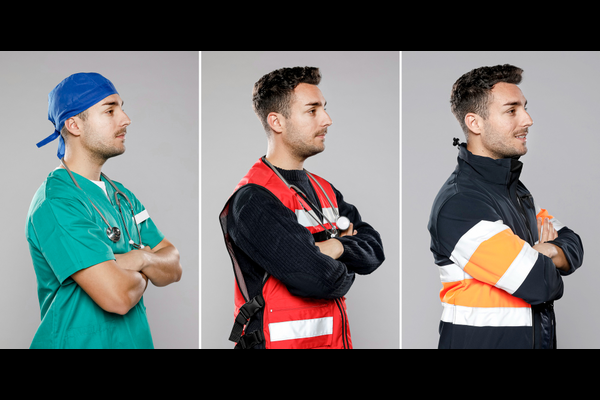Exploring Diverse Types Of Workwear: Choosing The Right Fit
Workwear stands at the intersection of functionality, comfort, and professionalism. Understanding the diverse types of workwear options available is crucial for individuals across various industries seeking attire that aligns with both their roles and preferences.
Understanding the Variety in Types of Workwear
1. Corporate Attire
Corporate workwear reflects professionalism and often includes formal suits, blazers, dress shirts, and tailored trousers. These attires are common in office settings and formal business environments.
2. Medical and Healthcare Attire
Medical workwear prioritizes hygiene and comfort. Scrubs, lab coats, and specialized shoes are typical in medical professions, ensuring cleanliness and easy movement.
3. Industrial Workwear
Industries like manufacturing, construction, and engineering necessitate durable and protective workwear. Coveralls, high-visibility vests, safety helmets, and steel-toe boots are common in these sectors.
4. Hospitality and Service Industry Attire
In the hospitality sector, workwear varies from formal attire in upscale restaurants to casual uniforms in cafés. Aprons, chef coats, and branded uniforms are prevalent here. For that reason, it is necessary to choose right Types of Workwear.
5. Uniforms for Retail and Customer Service
Retail workwear focuses on brand representation and customer interaction. Store uniforms, name tags, and branded attire are essential for a consistent brand image.
6. Outdoor and Recreational Workwear
Professions involving outdoor activities demand specialized workwear. This includes hiking gear, fishing apparel, waterproof clothing, and specialized footwear.
Factors to Consider When Choosing The Best Types of Workwear
Factors like functionality, comfort, safety, and industry standards play a pivotal role in selecting appropriate workwear. Assessing these criteria ensures that the chosen attire not only aligns with the job's demands but also provides ease and safety to the wearer.
1. Job Requirements
Understanding the specific requirements of the job is paramount. Assess the potential hazards, environmental conditions, and tasks involved. For instance, workers in construction may require high-visibility clothing, while those in the healthcare industry might need sterile and easily washable attire.
2. Safety Standards and Compliance
Compliance with safety standards and regulations is non-negotiable. Ensure that the chosen workwear meets industry-specific safety standards. Look for certifications indicating compliance with safety regulations to guarantee adequate protection for workers.
3. Comfort and Fit
Comfort plays a pivotal role in workwear selection. The attire should facilitate ease of movement and not restrict the wearer during tasks. Additionally, properly fitting workwear enhances comfort, reducing the risk of accidents caused by loose or ill-fitting clothing.
4. Material and Durability
Consider the durability and quality of materials used in the workwear. Depending on the work environment, select fabrics that offer resistance to wear and tear, withstand harsh conditions, and provide longevity to the attire.
5. Climate and Environmental Conditions
Factor in the climate and environmental conditions of the workplace. In hot climates, breathable and moisture-wicking fabrics are preferable, while in colder conditions, insulated and weather-resistant attire may be necessary.
6. Brand Representation and Uniformity
For industries focusing on brand representation, opting for customized workwear that showcases company logos or colors might be essential. Uniformity in appearance promotes professionalism and creates a cohesive brand image.
7. Cost-Effectiveness
While quality is crucial, considering cost-effectiveness is also prudent. Investing in high-quality workwear that meets safety standards and lasts longer can be cost-effective in the long run compared to frequent replacements of low-quality attire.
8. Maintenance and Care
Evaluate the ease of maintenance and care required for the chosen workwear. Some fabrics may demand specialized cleaning methods or frequent maintenance, impacting overall convenience and costs.
Industrial Workwear by Unito
Industrial workwear stands as a crucial component in the world of occupational safety and productivity. Catering to a diverse array of industries such as manufacturing, construction, engineering, and more, this specialized attire plays a pivotal role in safeguarding workers and enhancing efficiency in hazardous environments.
a). Functionality and Protection
Industrial workwear prioritizes functionality and protection above all. The attire typically includes coveralls, high-visibility vests, safety helmets, safety glasses, gloves, and steel-toe boots. These garments are specifically designed to shield workers from potential hazards including chemical exposure, impact injuries, and extreme weather conditions.
b). Durability and Quality
Durability remains a cornerstone in industrial workwear. The garments are crafted from robust materials that withstand rigorous use, ensuring prolonged durability. Additionally, high-quality fabrics provide resistance against wear and tear, extending the lifespan of the attire and offering long-term protection to workers.
c). Compliance with Safety Standards
Adherence to safety regulations and standards is paramount in the design and production of industrial workwear. These garments often comply with industry-specific safety standards and certifications to ensure optimal protection for workers in high-risk environments.
d). Enhanced Visibility and Identification
High-visibility clothing is prevalent in industries such as construction and roadwork. The bright, fluorescent colors coupled with reflective strips significantly enhance visibility, reducing the risk of accidents and aiding in the identification of workers in low-light conditions or areas with heavy machinery.
e). Customization and Branding
Moreover, industrial workwear can be customized and branded to reflect the company's identity. This not only fosters a sense of belonging among employees but also promotes brand recognition and professionalism in the workplace.
f). Ergonomics and Comfort
Modern industrial workwear emphasizes ergonomic designs to ensure comfort without compromising safety. The attire is crafted to facilitate ease of movement, ventilation, and moisture management, enhancing wearer comfort during long hours of labor-intensive tasks.
Conclusion
In essence, industrial workwear transcends mere clothing; it serves as a shield against occupational hazards, safeguarding the well-being of workers. From protective gear to enhancing visibility and ensuring compliance with safety standards, the significance of industrial workwear in various industries remains indispensable.
Workwear serves as more than just attire; it's a reflection of professionalism, functionality, and safety. The multitude of workwear options available caters to diverse industries and roles, ensuring individuals have the right clothing that meets their specific needs.
Follow us on:
Facebook | Instagram | LinkedIn | Twitter | Google My Business




